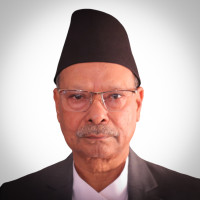- Monday, 5 January 2026
Despite popularity, ‘Aila Luwaya’ musician laments lack of support
Kathmandu, Dec. 30: Jhã jhã dhāla bhoye chhényā bhoye nayā
Le le tāla changu he khwā swayā
Ailā luwayā
Dhé dhé chula chhan ailā luwayā chanta swawayā
(Translation:
In banquet's bliss, a rhapsody unfurls,
Heart exults as your visage swirls.
You poured me the ambrosial liquor, so intoxicating,
I come to see thy elegance, so captivating)
If you have been to a party – any party – in these past two months, chances are you have heard this song.
Although in Nepal Bhasa, this song has become popular with people from all linguistic backgrounds and has accumulated over 4.7 million views on YouTube since its release on October 20.
This has overjoyed the song’s creator Roj Man Maharjan, much like the blissful alcohol he has written about.
“’Aila Luwaya’ owes its success to the people who have loved it and listened to it,” Maharjan, who conceptualised the track, wrote its lyrics and composed the music, told The Rising Nepal. “It is amazing to see how it has transcended ethnic boundaries.”
Amazing, but perhaps not unexpected. After all, Maharjan, who has a diploma from the Prayag Sangeet Samiti, Uttar Pradesh, India, made an active effort to include elements from various cultures.
Aila Luwaya’s language and setting are Newa, but it uses the folk Kathe beat common in Nepali-language Dohoris. In Maharjan’s own words, the song takes Dohoris (duet), an exchange of lyrical phrases between various characters, as a reference. The music also starts with the playing of the instrument Shehanai.
“I wanted to have a Newa song in a pan-Nepal style,” the 27-year-old musician shared, adding that he spent a year researching and developing
this number.
Maybe this cross-cultural nature is what made the song such a success. However, success and support are two different things, Maharjan has found out. He still has over Rs. 50,000 he needs to pay for the production of Aila Luwaya. But he has received little help.
“I have received much praise, but commendation does not pay the bills.”
“Non-Nepali language songs also do not get many shows and platforms,” he said. “There are limited means for musicians to sustain themselves.”
Maharjan shared that the ward office offered to give him Rs. 15,000. “But that is not even remotely enough.”
“The government spends money on building and rebuilding the same road three/four times a year. Can’t they allocate a certain budget for art and music?” he questioned.
The lack of sponsorships for ethnic music has also broken his heart. Businesses do not believe that indigenous songs can get them a large audience, even though Maharjan has a proven track record.
His song ‘Salugu Gacha,’ which he helped produce as part of the ensemble Kutupukhu Bhajan Khala and which was released last year, has been viewed 6.8 million times to date. On YouTube, there are over two dozen shorts prepared by remixing that video, and the song garnered acclaim from Nepal Bhasa and non-Nepal Bhasa speakers alike.
Kutupukhu Bhajan Khala is a musical group based in Khokana, Lalitpur. Maharjan, who also lives in Khokana, is a Tabala (hand drums) teacher in the group. The Khala has been credited in Aila Luwaya too.
Despite Salugu Gacha’s success, Maharjan said that he had a hard time getting support for Aila Luwaya. “This may be why indigenous communities do not produce songs in their mother tongues,” he wondered. “If we can get [monetary] offers on only Nepali hits then why should we continue making music in our language?” he expressed his frustration.
“People criticise musicians for overlooking their mother languages but rarely pay attention to the conditions that force them to make that decision.”
YouTube could have been a potential source of income, but Maharjan initially did not look at it like that. He has only now begun the process of monetising his channel, meaning that despite his videos’ popularity, he has not been able to receive any money from the platform.
But support or not, Maharjan is determined to complete what he called his Nepal Bhasa “hat-trick.” After Salugu Gacha, which used a centuries-old folk melody, and Aila Luwaya, which was an original composition, Maharjan shared his will to produce a third song, which he hinted could be in his own voice.
And he is optimistic too. “From the feedback and pledges I have received, I have hope that I will get more assistance for the production of this third song than I got for the first two.”



-original-thumb.jpg)
-square-thumb.jpg)








